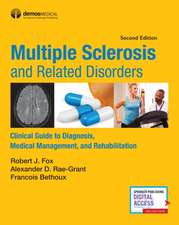How to Read an EEG
Autor Neville M. Jadejaen Limba Engleză Paperback – 14 iul 2021
Preț: 308.34 lei
Preț vechi: 324.58 lei
-5% Nou
59.00€ • 61.48$ • 48.85£
Carte disponibilă
Livrare economică 13-27 martie
Livrare express 27 februarie-05 martie pentru 24.92 lei
Specificații
ISBN-10: 1108825648
Pagini: 268
Dimensiuni: 124 x 186 x 13 mm
Greutate: 0.27 kg
Editura: Cambridge University Press
Colecția Cambridge University Press
Locul publicării:Cambridge, United Kingdom
Cuprins
Part I. Basics: 1. Introduction; 2. Polarity; 3. Montages; 4. Localization; 5. Active reference; 6. Frequencies and rhythms; 7. Maturation; 8. Normal adult EEG; Part II. Interpretation: 9. Approach to EEG reading; 10. Background; 11. Foreground; 12. Common artifacts; 13. Normal variants; 14. Sporadic abnormalities; 15. Repetitive abnormalities; 16. Ictal patterns (electrographic seizures); 17. Activation procedures; Part III. Specific conditions: 18. Common seizure mimics; 19. Seizures; 20. Epilepsies; 21. Epilepsy syndromes; 22. Focal dysfunction (lesions); 23. Global dysfunction (encephalopathy); 24. Status epilepticus; 25. Post cardiac arrest; 26. Brain death.
Recenzii
Descriere
The EEG is a simple and widely available neurophysiological test that, if interpreted correctly, can provide valuable insight into the functioning of the brain. However, despite its increasing usage in a range of settings, there is a common misconception that the EEG is inherently difficult to interpret. Compounding the problem is the lack of dedicated training and no standardized approach by encephalographers. This book provides a clear and concise guide to reading and interpreting EEGs in a systematic way. Presented in three sections, the first delivers foundational technical knowledge of how EEGs work, and the second concentrates on a comprehensive, stepwise approach to reading and interpreting an EEG. The third section contains examples of EEGs in common scenarios, such as seizures and post-cardiac arrest, enabling readers to correlate their findings to clinical indications. Heavily illustrated with over 200 example EEGs, this is an essential pocket guide to interpreting these tests.





















